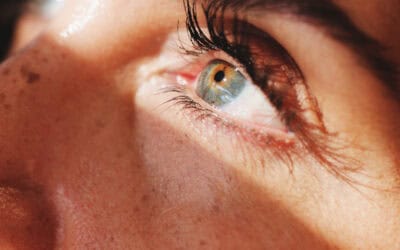More than half of all Americans over 80 either have cataracts or have undergone surgery to remove them. The daily choices you make each day directly determine whether you will add to this statistic in the future.
Cataracts work silently, developing slowly without disturbing your vision in early stages. This makes them particularly dangerous: you won’t notice changes in your eyesight until significant damage has already occurred. Vision loss happens gradually, then suddenly becomes apparent when daily activities like reading or driving become difficult.
Experts predict that about 50 million Americans will have cataracts by 2050. As a leading cause of blindness in the United States, cataracts represent a growing threat to your independence and quality of life.
The good news: many cataract risk factors remain within your control.
The lifestyle choices you make significantly impact your eye health, from smoking and alcohol consumption to managing diabetes and high blood pressure. In fact, research reveals that moderate alcohol consumption (fewer than two drinks daily) may actually lower your cataract risk compared to heavy drinking or complete abstinence.
This guide explores proven natural strategies that can protect your eye health and potentially prevent or delay cataract formation. These evidence-based approaches can become part of your daily routine, giving you the best chance at maintaining clear vision throughout your life. Whether you’re looking to prevent cataracts or slow their progression, the steps you take today will determine how well you see tomorrow.
What Really Happens When Cataracts Form
Cataracts don’t develop randomly. Scientists have identified specific biological processes that transform clear lenses into cloudy barriers to vision. Understanding these mechanisms reveals which risk factors you can control.
How aging affects your eye lens
The natural aging process drives most cataract formation. After age 40, lens proteins begin breaking down and clumping together. Think of these proteins like building blocks that maintain perfect organization for decades, then gradually lose their structure.
These protein changes follow a predictable pattern. Lens proteins undergo non-enzymatic modifications, accumulate fluorescent chromophores, and become increasingly susceptible to oxidation and cross-linking. What makes this process particularly problematic is that your lens continues growing throughout life, creating unique challenges that other parts of your body don’t face.
Usually during our 40s, a critical barrier will begin forming around the lens nucleus that blocks protective glutathione transport. This leaves the inner lens vulnerable to damage and the possibility of developing vision-impairing cataracts.
Free radicals: the true culprit behind lens damage
Oxidative stress acts as the trigger that sets cataract formation in motion. Free radicals are unstable molecules that attack and damage healthy cells in the lens, causing oxidative damage to lens proteins. This damage creates:
- Cross-linking of proteins
- Formation of high-molecular-weight aggregates
- Increased light-scattering
- Gradual loss of lens transparency
Your lens normally defends itself using antioxidants like glutathione (GSH), however this natural defense declines almost linearly with age. Meanwhile, oxidized glutathione concentrations increase correspondingly, weakening your eye’s natural defense system. This creates a perfect storm where damage accelerates just as protection weakens.
Other factors that accelerate damage beyond aging
Several factors can speed up cataract development beyond normal aging. Traumatic cataracts form in up to 65% of eye injuries, while long-term corticosteroid use significantly increases risk.
Additional contributors include:
- Diabetes and elevated blood sugar
- Prolonged UV radiation exposure
- Smoking and excessive alcohol consumption
- High blood pressure
- Previous eye surgery or inflammation
- Family history of cataracts
Over 70 different medications have been linked to increased cataract risk. The most commonly prescribed include glucocorticoids, psychotropic drugs, and statins—medications with tens of millions of prescriptions filled each year.
Eight Science-Backed Strategies That Actually Work
Taking action today can dramatically reduce your cataract risk tomorrow. These natural prevention methods have solid research backing and can easily become part of your daily routine.
1. Eat a diet rich in antioxidants
Your eyes face constant attack from free radicals that damage lens proteins. Antioxidants act as your first line of defense, neutralizing these harmful molecules before they can cause permanent damage.
Focus on vitamin C-rich foods like bell peppers, citrus fruits, and broccoli. Vitamin E offers additional protection which can be consumed from nuts, seeds, and green leafy vegetables to shield your eyes from oxidative stress. Learn more about foods that best nourish and protect your eyes in this article from Chang Eye Group.
2. Add more lutein and zeaxanthin to your meals
These powerful carotenoids specifically accumulate in your eyes and protect the lens from harmful UV rays. Your body can’t produce these nutrients, so you must get them from food.
The recommended daily intake is approximately 10mg of lutein and 2mg of zeaxanthin. Kale leads the pack with about 39mg per 100g, while spinach provides 11.9mg per 100g. Egg yolks, corn, peas, and orange peppers offer excellent sources too. For better absorption, consume these nutrients with healthy fats like olive oil or avocado.
3. Quit smoking to reduce oxidative damage
Smoking doubles or triples your cataract risk by flooding your eyes with free radicals. Studies reveal that smokers are two to three times more likely to develop cataracts compared to non-smokers.
Even after quitting, it can take over 20 years for your risk to approach that of someone who never smoked. But don’t let this discourage you because quitting at any age provides substantial benefits for your overall eye health.
4. Wear sunglasses with UV protection
UV radiation damages lens proteins through glycation, creating the cloudiness characteristic of cataracts. Your eyes need protection every time you step outside.
Choose sunglasses that block 100% of both UVA and UVB rays. Pair them with a broad-brimmed hat during peak sun hours for maximum protection. UV rays penetrate clouds, so wear protection even on overcast days.
5. Limit alcohol to reduce inflammation
Heavy drinking significantly increases cataract risk in multiple ways. Alcohol promotes dehydration, raises inflammation, and increases salt concentration in tears and blood.
Studies suggest a U-shaped relationship between alcohol consumption and risk: moderate consumption (1-2 drinks daily) might be associated with a 50% lower cataract surgery risk compared to either abstinence or heavy drinking. This doesn’t mean you should start drinking if you don’t already, but it suggests moderation may be key.
6. Control blood sugar if you have diabetes
Elevated blood glucose accelerates cataract formation, particularly in younger people with diabetes. When blood sugar remains high, your eye lens swells as it converts glucose into sorbitol, which collects in the lens and causes distortion.
Regular exercise, proper medication adherence, and a balanced diet help maintain healthy blood sugar levels and protect your vision. These same strategies that protect your overall health also preserve your eyesight. You can learn more about how diabetes affects your eyes by reading a recent article from the Chang Eye Group ophthalmologists in Pittsburgh.
7. Avoid long-term use of corticosteroids
Long-term corticosteroid use significantly increases your risk of developing posterior subcapsular cataracts. People using both inhaled and oral corticosteroids face the highest risk.
If you require these medications for conditions like asthma or arthritis, discuss the potential risks with your doctor. Explore alternatives or seek the lowest effective doses whenever possible.
8. Maintain a healthy weight and exercise regularly
Regular physical activity enhances blood circulation to your eyes, delivering essential nutrients while removing toxins. Research indicates that individuals with higher physical activity levels have up to 70% lower risk of developing age-related macular degeneration compared to those leading sedentary lifestyles.
Exercise also helps control other cataract risk factors like diabetes, hypertension, and inflammation. The same activities that keep your body healthy also protect your vision.
Making Eye Health a Lifelong Priority
Prevention strategies work best when paired with consistent professional monitoring. Regular eye exams catch cataracts, glaucoma, AMD and other conditions before they steal your vision, often years before you notice any symptoms.
Your eyes need regular check-ups
Eye exams serve as your first line of defense against cataracts and other vision problems. Many eye diseases progress without noticeable symptoms in their early stages, making detection difficult without professional evaluation. Comprehensive dilated eye exams allow doctors to examine your eyes completely and check for signs of health problems, sometimes even spotting conditions like high blood pressure or diabetes.
For cataract prevention specifically, these examinations remain crucial because they enable your optometrist to identify early lens changes before they significantly impact your vision. Early detection of cataracts allows for timely intervention, which can slow disease progression and preserve your remaining vision.
When to schedule your eye exams
Your exam schedule should match your age and risk factors:
- Ages 20-39: At least one eye exam during your 20s and two during your 30s
- Ages 40-54: Every 2-4 years
- Ages 55-64: Every 1-3 years
- Ages 65+: Annually or every 1-2 years
You’ll need more frequent check-ups if you have diabetes, high blood pressure, a family history of eye disease, or wear contact lenses. Those with diabetes should have a dilated eye exam every year. Your eye doctor can advise you to the optimal scheduling based on your unique health and lifestyle.
Early warning signs of cataracts you shouldn’t ignore
Between regular exams, watch for these early warning signs of cataract development:
- Blurry or cloudy vision that doesn’t improve with a new prescription
- Increased difficulty seeing at night or sensitivity to glare, especially from headlights
- Fading or yellowing of colors
- Frequent changes in eyeglass or contact lens prescriptions
If you notice any of these symptoms, schedule an eye exam immediately with Chang Eye Group in Pittsburgh. Early diagnosis often makes the difference in preserving your vision. Cataracts develop gradually, making self-detection challenging without professional help.
When to Talk to an Eye Doctor
Prevention strategies can significantly reduce your cataract risk but knowing when to seek medical attention remains equally important.
Don’t wait for obvious symptoms to appear!
Early intervention makes the difference between preserving your vision and losing it permanently.
Warning signs that require immediate action
Even with the best prevention efforts, you should contact an eye doctor immediately if you notice:
- Clouded or blurry vision that doesn’t improve with new glasses
- Difficulty seeing at night or in low-light conditions
- Increased sensitivity to light and glare, especially from headlights
- Seeing “halos” around lights or experiencing double vision in one eye
- Fading or yellowing of colors that previously appeared vibrant
- Frequent prescription changes for eyeglasses or contact lenses
Seek emergency eye care immediately if you experience sudden onset of floaters and flashes or a shadow spreading across your line of sight, as these may indicate a rare but serious complication such as a retinal detachment.
Questions to ask your eye doctor
When you visit your eye doctor, come prepared with these essential questions:
- Do I have signs of cataracts and how severe are they?
- What type are they and where are they located in my lens?
- Are both eyes affected or just one?
- When might I need surgery, and what are the risks for my specific situation?
- What can I do to see better until surgery becomes necessary?
- What lifestyle changes would you recommend?
What happens during your cataract evaluation
A comprehensive cataract evaluation takes about 90 minutes and may include several specialized tests depending on your previous appointment history with the eye doctor. Some typical areas that are covered include:
- Medical history review: Your doctor will discuss your symptoms, medications, and overall health
- Visual acuity test: Measures how well you see at various distances
- Dilated eye examination: Special drops widen your pupils, allowing your doctor to examine your lens, retina, and optic nerve in detail
- Tonometry: Measures pressure inside your eyes to detect conditions like glaucoma
- Refraction test: Determines if vision changes can be corrected with glasses
Your doctor will discuss treatment options based on your specific findings. Remember that cataracts develop gradually, making self-detection challenging without professional evaluation.
If you’re experiencing any vision changes or it’s time for your general eye exam, schedule an appointment at Chang Eye Group in Pittsburgh. Don’t wait until symptoms become obvious; by then, permanent damage may have already occurred.
Protecting Your Vision for the Years Ahead
Your vision at 80 depends on the choices you make today. While cataracts affect more than half of Americans in their eighties, understanding how to prevent them naturally gives you significant control over your eye health future.
The eight strategies we’ve explored work because they address the root causes of cataract formation. Antioxidant-rich foods neutralize the free radicals that damage lens proteins. UV protection prevents the glycation process that clouds your lens. Quitting smoking reduces oxidative stress throughout your body. Managing blood sugar levels prevents glucose from converting to sorbitol in your lens.
These aren’t just eye health practices but rather they are investments in your overall wellbeing. The same habits that protect your vision also reduce your risk of diabetes, heart disease, and other age-related conditions. Your eye health connects to your entire body’s health in ways that extend far beyond your ability to see clearly.
Regular eye exams remain your safety net. Even with the best prevention strategies, professional monitoring ensures that any changes in your lens can be detected and addressed before they significantly impact your daily life. Remember that cataracts develop gradually, often without symptoms you’d notice on your own.
The most encouraging news about cataract prevention is how much power you have. Unlike many age-related conditions, cataracts respond well to lifestyle interventions. Your daily food choices, activity levels, and protective habits create a foundation that can preserve clear vision for decades.
Whether you’re in your 40s and just beginning to think about eye health or already noticing vision changes, these natural prevention strategies offer meaningful protection. The steps you take now including eating nutrient-dense foods, protecting your eyes from UV damage, staying active, and scheduling regular eye exams will give your vision the best chance to remain clear and functional throughout your life.
Don’t wait for symptoms to appear. Schedule your next eye exam with Chang Eye Group in Pittsburgh and take the first step toward protecting your vision for the years ahead.
FAQs
Q: What are some natural ways to prevent cataracts?
A: Some effective natural ways to prevent cataracts include eating a diet rich in antioxidants, wearing UV-protective sunglasses, quitting smoking, limiting alcohol consumption, maintaining a healthy weight, and exercising regularly. These lifestyle changes can help protect your eyes from oxidative damage and reduce the risk of cataract formation.
Q: Can certain foods help prevent cataracts?
A: Yes, certain foods can help prevent cataracts. Foods rich in antioxidants, particularly vitamin C, vitamin E, and carotenoids like lutein and zeaxanthin, are beneficial. Good choices include citrus fruits, leafy green vegetables, nuts, seeds, and colorful fruits and vegetables. These nutrients help protect the eye’s lens from oxidative stress and damage.
Q: How often should I have my eyes examined to detect cataracts early?
A: The frequency of eye exams depends on your age and risk factors. Generally, adults aged 40-54 should have an eye exam every 2-4 years, those 55-64 every 1-3 years, and those 65 and older annually or every 1-2 years. However, if you have risk factors like diabetes or a family history of eye disease, you may need more frequent check-ups.
Q: What are the early signs of cataract development?
A: Early signs of cataract development include blurry or cloudy vision that doesn’t improve with a new prescription, increased difficulty seeing at night, sensitivity to glare (especially from headlights), seeing “halos” around lights, fading or yellowing of colors, and frequent changes in eyeglass or contact lens prescriptions. If you notice any of these symptoms, it’s important to schedule an eye exam.
Q: Can controlling blood sugar help prevent cataracts?
A: Yes, controlling blood sugar levels can help prevent cataracts, especially for people with diabetes. High blood glucose can cause the eye’s lens to swell and convert glucose into sorbitol, which collects in the lens and causes distortion. Maintaining healthy blood sugar levels through proper diet, regular exercise, and medication adherence (if prescribed) can significantly reduce the risk of cataract formation.






